#PostProducer
Explore tagged Tumblr posts
Text
“One cannot understand reality without understanding cinema, photography, 3D modeling, animation, or other forms of moving or still image. The world is imbued with the shrapnel of former images … Reality itself is postproduced and scripted, affect rendered as after-effect. Far from being opposites across an unbridgeable chasm, image and world are in many cases just versions of each other … This assigns a new role to image production, and in consequence also to people who deal with it.”
--Hito Steyerl, "Too Much World: Is the Internet Dead?," e-flux Journal, November 2013, e-flux.com.
21 notes
·
View notes
Text
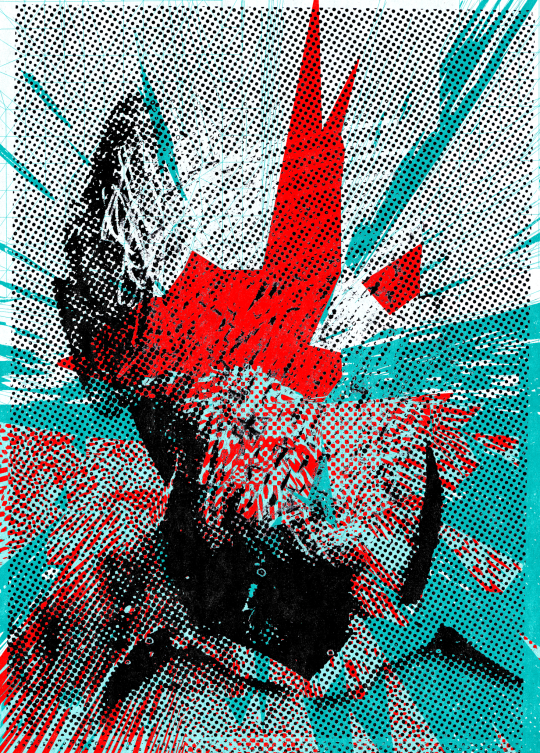
4 notes
·
View notes
Video
vimeo
Tipico Campagne 2025 from James F. Coton on Vimeo.
Client: tipico Agency: deepblue HoP & MP: Tim Beblo Producer: Marc Haferbusch PC: Dag Pepeonik PA: Jan Wittmann ServiceProduction: Creme fraiche ServiceProducer: Rasto Kuril LineProducer: Jan Melikant ProductionManager: Majo Nemeth ProductionCoordinator: Dasa Parizkova AssistPM-Photo: Dominika Zelinkova 2ndAD: Tatiana Lutherova 2ndUnitAD: Marco Rubiero SetProductionAsst: Peter Jaroš UnitManager: Andrej Babic ProductionAssistant: Róbert Dando ProductionChaperon: Juraj Spacek LocationManager: Patrick Horvath AgencyChaperon: Michal Spacek Director: James F. Coton AgentDirector: Rick Romaniuk DOP: Denis Guth AgentDOP: Esther Kurle 2ndUnitDoP: Marco Schott 1stAD: Niki Sauer ProductionDesigner: Adrian Cristea AgentPD: Esther Kurle FPVDrone: House of FPV - Benoit Finck FPVDroneAssistant: House of FPV - Martin Lelong Photographer: Pascal Kerousche DigiTech: Marvin Darko SteadyCam: Felix Lang VFXSupervisor: Vitaliy Havrylyuk 1stAC: Radka Sisulakova 2ndAC: Jaro Durkovic 1stAC2ndUnit: Jakub Martinek 2ndAC2ndUnit: Rado Novosad DIT: Martin Dolejs VTR: Michal Filus Gaffer: Tomáš Miťko KeyGrip: Peter Pucik ArtDirectorSVK: Ema Teren PropsMaster: Tomáš Bakočka SFX: Dušan Prvý Styling: Frecks (Laura Fries & Caroline Schreck) HairMakeUpSVK: Mirka Baluchova FootballCoreographer: Ismail Wali Casting: Tobias Kraustrunk/Deebeephunky Cast: Leonardo Artem Benndorf-Gornev, Farid Atrian, Joseph Russell, Adrian Zagorski, Jay Jay Randhawa, Luke Shearer, Jair Ocoro, Torin Hamill PostProducer: Sam Cody x Florian Schmuck Editor: James Coton Editor: Max Paschke EditorGames: Laurin Tomaschewski Colorist: Arthur Paux VFXArtist: Chris Roemer VFXAgency: Mose Mgmt VFXArtist: Okko Käyhkö VFXArtist: Marco Pelzel VFXArtist: Michael Welz OnlineArtist: Folke Arnecke GraphicArt: KIM&HIM SoundDesignMix: Hastings Audio Network
0 notes
Video
vimeo
Tipico 2025 DC from Denis Guth on Vimeo.
Client: @tipico_de Agency: @deepblue_networks HoP&MP: @timbeblo Producer: Marc Haferbusch Prodco: @27km Director: @jamesfcoton AgentDirector: @bittertiger @nicholasberglundfilms DOP: @denisguth AgentDOP: Esther Kurle 2ndUnitDoP: @marco_schott PC: @pepedagg PA: @jan_wittmann ServiceProduction: @cremefraichefilms ServiceProducer: @cremefraichefilms LineProducer: Jan Melikant ProductionManager: Majo Nemeth ProductionCoordinator: Dasa Parizkova AssistPM-Photo: Dominika Zelinkova 2ndAD: Tatiana Lutherova 2ndUnitAD: Marco Rubiero SetProductionAsst: Peter Jaroš UnitManager: Andrej Babic ProductionAssistant: Róbert Dando ProductionChaperon: Juraj Spacek LocationManager: Patrick Horvath AgencyChaperon: Michal Spacek 1stAD: @niki_sauer77 ProductionDesigner: @adrian.cristea AgentPD: Esther Kurle FPVDrone: @benoitfinck x @houseoffpv FPVDroneAssistant: @houseoffpv Photographer: @mmpascal DigiTech: @marvindarko SteadyCam: @steadicamop_de VFXSupervisor: @vitaliyhavrylyuk 1stAC: @radoslavomira 2ndAC: Jaro Durkovic 1stAC2ndUnit: Jakub Martinek 2ndAC2ndUnit: Rado Novosad DIT: Martin Dolejs VTR: Michal Filus Gaffer: Tomáš Miťko KeyGrip: @gripzone.eu ArtDirectorSVK: Ema Teren PropsMaster: Tomáš Bakočka SFX: Dušan Prvý Styling: @friesundschreck HairMakeUpSVK: @mirkabaluchova_makeup FootballCoreographer: @isoolinho Casting: @tobikrautstrunk x @deebeephunky.int.casting Cast: @farid.atrian_ x @joeruss3ll x @adi.zagorski x @j.rxndhawa x @lukeshearer x @jair_ocoro x @torinhamill PostProducer: Sam Cody x Florian Schmuck Editor: @jamesfcoton Editor: @maxpaschke EditorGames: @laurin_lights Colorist: @arthurpaux VFXArtist: @chrisroemer VFXAgency: @mosemgmt VFXArtist: @okkoboomin VFXArtist: Marco Pelzel VFXArtist: Michael Welz OnlineArtist: Folke Arnecke GraphicArt: @kimandhim.animators SoundDesignMix: @hastingsaudionetwork
0 notes
Video
Orange SPRING | Potrzeby rosną ! from Marcin Filipek on Vimeo.
Director: Marcin Filipek | Point of You
DOP: Wojtek Zieliński | Match&Spark
Client: Orange Polska
Agency: Leo Burnett Warszawa Agency Producer: Jolanta Skuza Creatives: Tomek Nowak, Kamila Ługowska, Radek Dudzic Account Director: Małgorzata Bęczkowska Client Service: Agnieszka Makarewicz
Production House: Film Produkcja Producer: Monika Nowak Production Manager: Manuela Bagińska Production Coordinator: Ania Rundsztuk Production Assistant: Karolina Panasiuk
Offline: Magda Mikołajczyk Grading: Piotr Sasim
Postproduction House: Orka Postproducer: Magda Rokicka, Genevieve Assaf Sound: Lunapark Photographer: Katarzyna Bielska
Set designer: Agnieszka Tepli Costume designer: Hania Bartoś Make up: Gosia Sulima Gaffer: Patryk Zadrożny / Heliograf Steadicam: Marek Borniński Key Grip: Arkadiusz Płachta „Stalowy” Set manager PL: Michał Dąbrowa Location Manager PL: Daniel Krajewski 1AD: Konrad Nadrowski Casting: Magda Daniel
0 notes
Text

Color Correction Service
There are moments when the photos your photographer takes are flawless. It is necessary to postproduce the photos. It is crucial that the color of your photos complements both the original hue and the color palette of your business. To reach a larger audience, you may occasionally need to draw attention to a particular product feature or create many color variations of a same product. To increase the possibility of a sale, image editors do all of these tasks through color correction.
#ColorCorrectionService#Professionalcolorcorrectionservice#Colorcorrectionservicenearme#Bestcolorcorrectionservice#Colorcorrectionservicelondon#imagecolorcorrectionservice#haircolorcorrectionservices#colourcorrectionlondon#fiverrcolorcorrection
0 notes
Text
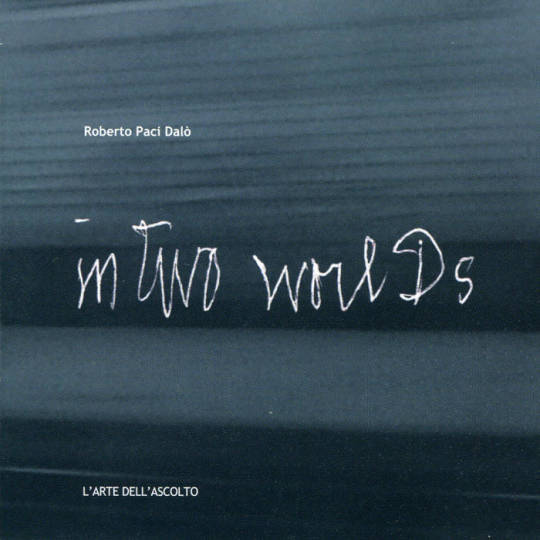
Roberto Paci Dalò In Two Worlds
01. Elie 02. Code 03. Files 04. Remix 05. Tallinn
All compositions by Roberto Paci Dalò. 2002 handwritten text a mesostic by John Cage dedicated to Roberto Paci Dalò design Lora Casadei thanks Vincent Delvaux, Andrea Felli, Philippe Franck, Gabriele Frasca, Lab[au], Andres Loo, Maks Surin, Fujui Wang L'Arte dell'Ascolto –a project of Giardini Pensili produced by Roberto Paci Dalò © 2004 Roberto Paci Dalò (p) 2004 L'Arte dell'Ascolto In Two Worlds backstage
The title comes from a mesostic John Cage wrote after concert I gave in New York City at the Experimental Intermedia Foundation A great venue - directed by composer Phill Niblock - which is still keeping the "loft" atmosphere of the 60's. John came to the concert and few days later we met in his flat. At that occasion he gave me this mesostic which obviously is one of the most important (very few) things I own! Elie is dedicated to cellist/composer/conductor Jean-Paul Dessy's son. I created the piece in my former studio in Rome in may 2002. Code, Files, Remix originally are one single composition commissioned by the Netdays Festival in Brussels 2002. Philippe Franck and Vincent Delvaux / Transcultures proposed to me the making of a sound piece as a collaborative project together with media architects Lab[au] (laboratory for architecture and urbanism) in order to produced an installation in the public space: RE:MAP Instead of dealing solely with my own usual materials, I thought that was probably more interesting to think about other musicians presence at the festival. So I sampled sounds from works by all of them and with this database I created the piece. This installation work has been presented in Brussels next to the Brigittines, a former beautiful little church converted now into a performing arts space. Tallinn has been recorded live in concert in Tallinn (Estonia) in 2002. I've been invited to perform there by a friend: Maksim Surin cult figure of the Estonian scene. I love Estonia and Nordic countries in general and I particularly enjoyed that event. That's why I wanted to include e little excerpt in this first album.
All these pieces have a lot to do with my interested in cities and urban sonic & visual explorations. Kind of environmental pieces dealing with city life. I took the photographs in the CD during a painful and endless night trip by train from Torino to Rome. Everything has been mixed and postproduced at the Giardini Pensili Studio between Rome and the Rimini hills. – RPD L'Arte dell'Ascolto LADA001
0 notes
Video
vimeo
There's a Collection in Everyone | Pokemon TCG x Platige Image from Platige Image on Vimeo.
Director: Claire Norowzian DOP: Kabeer Shaik Postproducer: Sonia Marcinkowska VFX Supervisor: Maciej Szewczenko
0 notes
Video
vimeo
MK - CHEMICAL (Director's Cut) from AUBE PERRIE on Vimeo.
Written and directed by Aube Perrie Director of photography : Raphaël Vandenbussche Production : Wanda Productions Producer : Anis Gaiji, Paul Le Baron Line producer : Anis Gaiji Production coordinator : Chloé Goueilhé Production assistant : Carla Pommaret Commissioner : Elena Argiros Director’s rep : Mouthpiece / Claire Stubbs Art direction : Aube Perrie & Louise Mekylla Bachir Casting director : Marie Gervais Location manager : Damien Notin
Starring Jamel Elgharbi, Thea Carla Schøtt & Pauline Vernet
Animatronics, mask creation & special effects : Project supervisor : Guy Bonnel (Illumine Creations) Dog hair : Mélanie Gerbeau Mechatronics : Pascal Molina SFX assistant : Kazuhito Kimura
Production designer : Louise Mekylla Bachir Production designer assistant : Margot Carreca Set dressers : Elisa Gaches Dufresne, Madé Beau Construction manager : Remi Borgnon Rippers : Antoine Sayn, Evan Sarreira, Shana Sarreira, Alicia Contini
Costume designer : Maud Dupuy Costume designer assistants : France Hofnung & Louise Faillot Hair & make-up artist : Jean Buisson-Ramey Hair & make-up assistant : Maya Chancelade 1st AD : Mathieu Perez 2nd AD: Lena Turlot 3rd AD : Sarah-Rebecca Bajavi 1st AC : Camille Autrive 2nd AC : Clémence Pittillioen 3rd AC : Juliette Le Bagousse
Gaffer : Paul Texier Electricians : Johan Van Der Voort, Théo Gély & Camille Benariac
Key grip : Lola Ruet Grips : Thibault David, Camille Conroy & William Sim
Sound recordist : Antoine Reiff
Runners : Léo Rodriguez, Bastien Rousseau, Jose Luiz Rodriguez & Christophe Moulet Postproducer : Vanessa Koscianski Editor : Gwen Ghelid Editor assistant : Pierrick Maurice Colorist : Anne Szymkowiak VFX flame artist : Vincent Heine Mix & sound design : Kouz / Sylvain Pierre
Tattoo graphic design : Charles Chedal-Anglay & Samy Bortolato Partners : Mouthpiece, Illumine Créations, Vantage, Cininter, Cinesyl, Hiventy, Cosmic Talents, Logifilm, La Rose
Music by MK
0 notes
Photo

Wout la pa fasil, men sa pa janm anpeche ke m ret fokis,anpil fwa fòs la febli, kouraj la bese men toujou gen youn nn nou k t la pou te bay "fòs" la, "ECHO" Pawòl nou fè ede n konprann youn lòt pou still propaje l tout kote. On gran Mèsi pou kreyatè, M big up manman ak gran frè m em met respè sou non koz nou se sòlda ki akonpanye m nan batay la. #bless #graduationday #graduation #graduated🎓 #soundengineer #postproducer https://www.instagram.com/p/BzYxQDWDXOg/?igshid=10d0e3tqpyo67
0 notes
Photo

Check out my LoGo designs at www.zelnonnenberg.net/design creative director design works #zelberg #creative #creativedirector #design #logo #designer #postproduction #postproducer #editor #videomaker #colorist #director #webdesign #webdesigner #app #appdesigner #visualart #visualartist #portfolio #reel #VFX #vfxartist #photoshop #premierepro #aftereffects #brazil #brazilians #riodejaneiro #brasil #novafriburgo #descubranovafriburgo (em Rio de Janeiro) https://www.instagram.com/p/BzRCROJgJDm/?igshid=qeoq30tnk09j
#zelberg#creative#creativedirector#design#logo#designer#postproduction#postproducer#editor#videomaker#colorist#director#webdesign#webdesigner#app#appdesigner#visualart#visualartist#portfolio#reel#vfx#vfxartist#photoshop#premierepro#aftereffects#brazil#brazilians#riodejaneiro#brasil#novafriburgo
0 notes
Photo
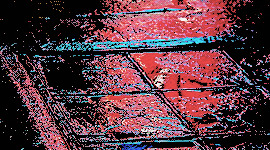





exclusive x base stage: “when the party’s over” (orig. billie eilish) by taeyong
“don't you know i'm no good for you? / i've learned to lose you, can't afford to / tore my shirt to stop you bleedin' / but nothin' ever stops you leavin' / quiet when i'm coming home and i'm on my own / i could lie, say i like it like that, like it like that”
the video opens with a pan across an abandoned alleyway, colored lights of nightlife that should be there but isn’t reflecting off of the wet ground. humming introduces the song as the viewer is allowed to settle into the scene. ash enters the frame from off-camera moments after he begins to sing.
#famedbasemagazine#// absolutely terrible choice for acoustics ash#// one would assume the audio is very postproduced#* | queued.
1 note
·
View note
Photo
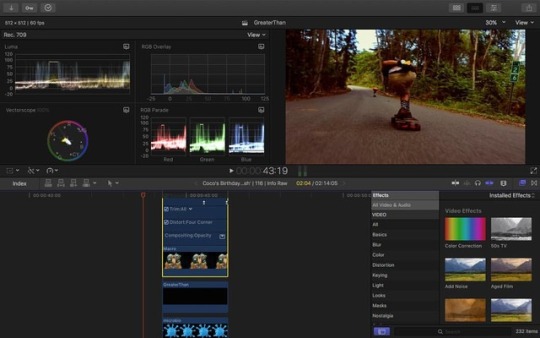
Just #producing some content for one of our proyects (@roadlesscrew). Go big or go home! Soon available on #RoadlessCrew #youtubechannel. #VictorGonzalez #VicG #RedAngel #rOc #apple #macbookpro #finalcutpro #videography #producer #editor #director #filmer #videographer #filmphotography #film #filmmaking #film #optrix #suctioncup #keyframe #colorcorrection #screenshot #videoedit #videoproduction #postproduction #postproducer
#filmer#filmphotography#videoedit#filmmaking#youtubechannel#editor#director#roc#finalcutpro#apple#postproduction#colorcorrection#screenshot#optrix#videographer#suctioncup#producing#redangel#vicg#postproducer#videography#macbookpro#film#videoproduction#producer#roadlesscrew#victorgonzalez#keyframe
1 note
·
View note
Video
Orange | Otwórz się na nowe ! from Marcin Filipek on Vimeo.
Director: Marcin Filipek | Point of You DOP: Wojtek Zieliński | Match&Spark
Client: Orange Polska
Agency: Leo Burnett Warszawa Agency Producer: Jolanta Skuza Creatives: Tomek Nowak, Kamila Ługowska, Radek Dudzic Account Director: Małgorzata Bęczkowska Client Service: Agnieszka Makarewicz
Production House: Film Produkcja Producer: Monika Nowak Production Manager: Manuela Bagińska Production Coordinator: Ania Rundsztuk Production Assistant: Karolina Panasiuk
Offline: Magda Mikołajczyk Grading: Piotr Sasim
Postproduction House: Orka Postproducer: Magda Rokicka, Genevieve Assaf Sound: Lunapark Photographer: Katarzyna Bielska
RPA CREW: RPA Production Service: Cyclone Films Producer: Anja Teufel Production Manager: Tarryn Greybe-Dunn Production Coordinator: Stephen Moser 1AD: Westley Durand Production Designer: Naobie Noisette Stylist: Estelle Gallacher Key Grip: Storm Williamson Gaffer: Dirk Bloemraad Steadicam: Justin Youens Unit/Locations Manager: Riaan Serfontein Chaperone: Chezlin Cross
PL CREW: Set designer: Agnieszka Tepli Costume designer: Hania Bartoś Make up: Gosia Sulima Gaffer: Patryk Zadrożny / Heliograf Steadicam: Marek Borniński Key Grip: Arkadiusz Płachta „Stalowy” Set manager PL: Michał Dąbrowa Location Manager PL: Daniel Krajewski 1AD: Konrad Nadrowski Casting: Magda Daniel
0 notes
Text
THE HONEY BEE
1913
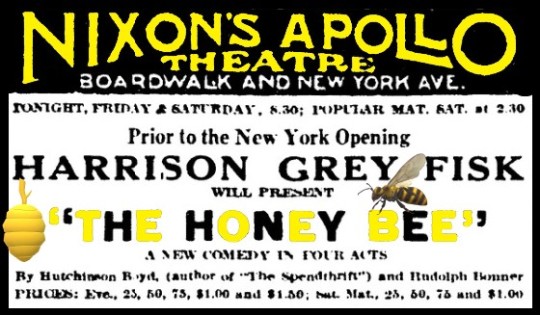
The Honey Bee is a play in four acts by Hutcheson Boyd and Rudolph Bunner. It was originally produced by Harrison Grey Fiske. The cast included Allan Pollock, Fanny Hartz, Marie Chambers, Benjamin Kauser, Eugene A. Hohenwart, Marion Pullar, and Norris and Helen Millington as the Witherspoon children.

[Note: All three of the creative staff’s names have been misspelled in the above ad from the Atlantic City Press.]
The play is set in an apartment loft in Hoboken NJ.
It was to mark the return of actress Marie Shotwell, who had ostensibly retired after her marriage to former Savannah GA police chief William G. Austin. However, when the play got to Atlantic City, Shotwell’s name was not on the cast list.
Allan Pollack was cast because his sketches for the scenery were tucked inside the manuscript of the play given to Harrison Fiske a year earlier. Instead, he wound up being cast to play Professor Witherspoon.
“Mr. Allan Pollock heads the cast. He appeared somewhat bewildered last evening. Eventually he seemed to give up his struggle to understand the drift of the play.” ~ THE WASHINGTON POST
Producer Harrison Grey Fiske was husband to the inimitable Mrs. Fiske, and the pair often worked together, but not with The Honey Bee.
“The play is presented by Mr. Harrison Grey Fiske, one of the most artistic and intelligent producers in America. We cannot understand why the manuscript attracted his attention.” ~ THE WASHINGTON POST
Rehearsal began on October 9, 1913 in Manhattan.

The play premiered in Atlantic City at Nixon’s Apollo Theatre on the Boardwalk on November 6, 1913. As per usual, it was touted as ‘Prior to the New York Opening.’ They forgot to mention that they were referring to New York state, not New York City!
“The plot baffles any auditor.” ~ THE WASHINGTON POST
After AC, the play moved to the Columbia Theatre in Washington DC, opening there on November 10th. While in Washington, the play was reviewed by their mistress of gossip, Julia Murdock.
[ed: I usually don’t reprint reviews in toto, but this one is well worth a read. For those of short attention span, I have bolded the pithy highlights.]


There’s a little rhyme at the head of the Columbia program this week which announces that when the wife forsakes the house and goes out Into the world, said house must, perforce, stand upon its head.
The little comedy, however, "The Honey Bee," which Harrison Grey Fiske is exploiting this week at the F street playhouse, will have to have something more satisfactory in the way of careful elocution and artistic action before it can stand on Its head or its heels or any other way very long. It has a number of clever lines, so clever, that even the actors themselves seem afraid of them and appear to give up and say "Dear me. this will never get across, so why try?" The man who goes to the theater with me occasionally says that some of these days, when the feminist movement Is as far back In history as the antiquated manners which make "She Stoops to Conquer" so delicious, "The Honey Bee" may be loved for Its witty lines, just as Goldsmith's comedy is loved for its wit. But this will never happen, as those who saw It last evening will be able to guess In three guesses.
The story or the plot, what there Is of It, leaves one bewildered, though one finds out in the course of the evening that it is all about a lamp which refuses to burn until the last act. The plot could have been made Into a rather acceptable twenty-minute vaudeville sketch and been the stronger for it. But It Is the lines, reams and reams of satire, that came to the audience only as the fruit of painful listening, that will make the play live, if It survives long-enough for the public to arrive at the right perspective of the New Woman.
Plot of Play. Told in Brief.
Prof. Witherspoon Invented a lamp, but before he had It perfected his funds gave out, and he moved. Into the most remarkable building In Hoboken, N.J. In this wonderful building Is the meager flat to which the Witherspoons moved, on the top floor; the studio to which his wife moved when she deserted him, on the floor below; and a hall which served as the meeting place of the Hoboken Choral Society. To the Hoboken flat of the professor, who has Invented the lamp, comes Mrs. Billy Martin, who has more money than, anyone ever has outside of a play. She persuades beautiful Mrs. Witherspoon, cleverly played by Fanny Hartz, that the lamp Is her own Invention, not the professor's, and that It Is up to her to boost the cause of woman by deserting her husband and herself and perfecting the wonderful lamp with the funds which Mrs. Billy places at her disposal.
It would be a fine piece of work but for a pair of Witherspoon children, portrayed by two wonderful child actors, Helen and Norris Millington, and a temporary lapse from sobriety with which the professor is impregnated at the hands of the German Socialist janitor of the Hoboken flat, who Is also the presiding genius of the Hoboken Choral Society. The wife cannot make the lamp go right, and the professor takes It up to his wifeless apartment and perfects it. The little Witherspoon boy has the whooping-cough, and the professor is no more adept with the child than his wife with the lamp. He puts the little fellow In the dumb waiter and lowers him to the wife In the flat below. Her success in caring for the little lad is equal to her failure with the lamp, and, of course, everybody is happy when It was disclosed that the lesson the play Is meant to convey Is that woman is more of a shining light In her own sphere of wifehood and motherhood than as a worker In the big, big, cruel world.
Some of Play's Trifling Details
There are such trifling divergent details as a titled suitor for the professor's wife's hand, after Mrs. Billy has convinced her that she must divorce her own husband, and much brave talk by this same Mrs. Billy about the cause of women; but, after all, the story Is told by the four quaint lines of verse that deck the program of the play.
If nothing else, Messrs. Hutcheson Boyd and Rudolph Bunner have enriched the stage with the novelty of as grotesque a garret as ever Sol Smith Russell graced, and with a play In which each single character is a type so novel as to be almost fascinating. The Professor, played by Allan Pollock, is such a type as could only exist In a play, but still a delight when he announces that the worm has turned under the influence of the potent cheer of the Choral Society punch. Marie Chambers makes Mrs. Billy Martin the newest of the New Women, and delightful Fanny Hartz makes an inimitable picture of the wife who has more gumption than her husband and whose husband more than half realizes it. Those precious Millington children, as Jack and Jill Witherspoon, are a delight during every minute they are on the stage. Barbarossa Marks, the Teutonic Janitor with the language and convictions of an anarchist and the heart of a child, played by Eugene A. Hohenwart, and his gum-chewing daughter. Gertrude, with the coiffure of a shopgirl and keen discernment, acted by Marian Pullar, are just the rough foils needed for the more delicate characters of Cecil Witherspoon and his high-powered wife.
There Is a count, played by Benjamin Kauser, who shrugs his shoulders, makes love, and kisses Mrs. Witherspoon on the back of her pleasing neck to perfection. And when I have mentioned the Mr. Smith of Bangor played by Roy Merrill, I have told you the names of every one of the nine people who make this play. I wish I could say that all the witty lines such as this: "Women are always angels when they leave us," are delivered with sufficient excellence of enunciation to be understood. They are not. The members of the cast all act well, but not one of them speaks as distinctly as they should, to do justice to this comedy of satire which Harrison Grey Fiske Is presenting to Washington this week. ~ JULIA MURDOCK
“The piece Is not a satire, neither does it point a moral.” ~ THE WASHINGTON TIMES
Despite ‘stinging’ reviews, The Honey Bee migrated to Rochester NY for a booking at the Lyceum starting November 20th, fulfilling its promise to play in New York!

After this booking, The Honey Bee, not unlike the insect it is named after, disappeared. They say that once a bee stings, it dies. Such was the fate of Boyd and Bunner’s play.
#The honey bee#Atlantic City#Broadway Play#Nixon's Apollo Theatre#1913#Harrison Grey Fiske#Hutcheson Boyd#Rudolph Bunner#Julia Murdock#Allan Pollock#Marie Shotwell#Theatre
3 notes
·
View notes
Text
NICOLAS BOURRIAUD POSTPRODUCTION CULTURE AS SCREENPLAY: HOW ART REPROGRAMS THE WORLD
This book fucking rocks and affirms many things about my practice. Good to know I am on a good path. Written in 2002, the text could not take into account the level of postproduction that would ensue in the following twenty years. This is the age of the consumer-producer. Everything is consumed and produced multiple times over. Bourriaud thought that artists processing their own consumption would take on liberatory pollitical effects. Unfortunately late capitalism has simply developed such that we no longer need ‘power’ to satiate us with entertainment, we are given the tools to satiate one another.... Below are really haphazard notes, not very well structured but all very important.
p7“Pop Art was born of a conjunction between the phenomenon of mass production and the birth of visual marketing, under the aegis of a new era of consumption” (p2)
“the works of Pierre Huyghe, Douglas Gordon, or Rirkrit Tiravanija deeply reexamine notions of creation, authorship, and originality through a problematics of the use of cultural artifacts - which, by the way, is absolutely new.” (p4)
“When artists find material in objects that are already in circulation on the cultural market, the work of art takes on a script-like value: "when screenplays become form," in a sense.” (p4)
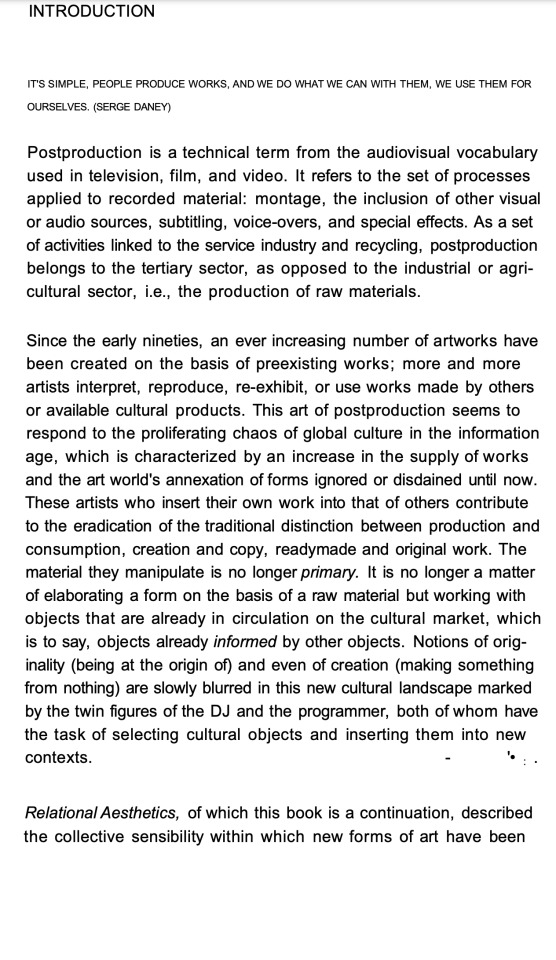
“Postproduction apprehends the forms of knowledge generated by the appearance of the Net (how to find one's bearings in the cultural chaos and how to extract new modes of production from it).Indeed, it is striking that the tools most often used by artists today in order to produce these relational models are preexisting works or formal structures, as if the world of cultural products and artworks constituted an autonomous strata that could provide tools of connection between individuals; as if the establishment of new forms of sociality and a true critique of contemporary forms of life involved a different attitude in relation to artistic patrimony, through the production of new relationships to culture in general and to the artwork in particular.” (p7) <<So important
It is no longer a matter of starting with a "blank slate" or creating meaning on the basis of virgin material but of finding a means of insertion into the innumerable flows of production. "Things and thoughts," Gilles Deleuze writes, "advance or grow out from the middle, and that's where you have to get to work, that's where everything unfolds."01 The artistic question is no longer: "what can we make that is new?" but "how can we make do with what we have?" In other words, how can we produce singularity and meaning from this chaotic mass of objects, names, and references that constitutes our daily life? (p8) BINGBINGBING
The activities of DJs, Web surfers, and postproduction artists imply a similar configuration of knowledge, which is characterized by the invention of paths through culture. Finding a way through, finding bearings, the endless trace through culture...
By using television, books, or records, the user of culture deploys a rhetoric of practices and "ruses" that has to do with enunciation and therefore with language whose figures and codes may be catalogued.
Commerce is above all a form of human relations, indeed, a pretext destined to produce a relationsship. Any transaction may be defined as "a successful encounter of histories, affinities, wishes, constraints, habits, threats, skins, tensions."(p15) << Reminds me of the andy warhol quote, “ Being good in business is the most fascinating kind of art. Making money is art and working is art and good business is the best art.”
Art tends to give shape and weight to the most invisible processes. When entire sections of our existence spiral into abstraction as a result of economic globalization, when the basic functions of our daily lives are slowly transformed into products of consumption (including human relations, which are becoming a full-fledged industrial concern), it seems highly logical that artists might seek to rematerialize these functions and processes, to give shape to what is disappearing before our eyes. Not as objects, which would be to fall into the trap of reification, but as mediums of experience: by striving to shatter the logic of the spectacle, art restores the world to us as an experience to be lived.
ARTISTIC DETOURNEMENT (DIVERSION) - DJing
A pollitcal application of duchampian readymade (using a rembrandt as an ironing board or erasing a De Kooning drawing)
The DJ’s work consists both of proposing a personal orbit through a musical universe (a playlist) and in paying attention to their sequence as well as the construction of atmosphere. One can recognize a DJ's style in the ability to inhabit an open network (the history of sound) and in the logic that organizes the links between the samples he or she plays. Deejaying implies a culture of the use of forms, which connects rap, techno, and all their subsequent by-products.
The curatorial process is an artistic one we know that already! But it can be tighter, more specific, weilded masterfully.
"Sometimes," Godard writes, "the class struggle is the struggle of one image against another image and one sound against another sound."
We must stop interpreting the world, stop playing walk-on parts in a script written by power. We must become its actors or co-writers. The same goes for works of art except now, the ‘power’ has given us the tools of creation such that we socially govern one another. The best marketing is user generated. pollitical agendas are spread through memesis. This is not the liberating scenario Bourriaud thought it would be in the early 2000′s
we are not saturated with images, but subjected to the lack of certain images, which must be produced to fill in the blanks of the official image of the community.
We are then very close to the "equivalence of everything, the good and the bad, the beautiful and the ugly, the insignificant and the distinctive"
to signify that everything was equal because everything could be consumed
Roland Barthes, asserts that culture is an infinite palimpsest. Considering each book to consist of "multiple writings, proceeding from several cultures and entering into dialogue, into parody, into protest," Barthes accords the writer the status of scriptor, an intertextual operator: the only place where this multiplicity of sources converges is in the brain of the reader-postproducer.
Boycotts, detournement, and piracy belong to this culture of activity. When Allen Ruppersberg recopied Oscar Wilde's The Portrait of Dorian Gray on canvas (1974), he took a literary text and considered himself responsible for it: he rewrote it.
No public image should benefit from impunity, for whatever reason: a logo belongs to public space, since it exists in the streets and appears on the objects we use, A legal battle is underway that places artists at the forefront: no sign must remain inert, no image must remain untouchable. Art represents a counterpower. Not that the task of artists consists in denouncing, mobilizing, or protesting: all art is engaged, whatever its nature and its goals. Today there is a quarrel over representation that sets art and the official image of reality against each other; it is propagated by advertising discourse, relayed by the media, organized by an ultralight ideology of consumption and social competition. In our daily lives, we come across fictions, representations, and forms that sustain this collective imaginary whose contents are dictated by power. BOOM
4 notes
·
View notes